by Stan Logan | May 31, 2022 | Senior Gardening
For those of you who are not familiar with E D, Easily Distracted Syndrome is a very common ailment which seems to become more prevalent in humans as they age—at least that has been my experience. Perhaps you have fallen prey to this same malady. As gardeners, here are some of the symptoms that you may have noticed:
You mean to leave water running in a particular area of your yard for 5 minutes, but discover hours later that it is still running. That happened to me last week when I let water run on a wisteria, and didn’t turn it off until 4 hours later when I returned from a medical appointment. Then, I have a dear friend who got distracted and flooded not only part of her back yard as well as her neighbor’s by letting a hose run all night.
You have accumulated a collection of well rusted tools. It was not your intention to leave tools out in the weather, but it has happened over and over again. I won’t name names, but after sharpening hundreds of your garden tools, I can definitely tell that some of you have a serious problem with E D.
You go in the garden with a particular task in mind. Hours later you realize that chore was never even started. Nothing will distract me faster that the sight of a weed that is producing seeds. And perhaps that distraction is justifiable because as you perhaps learned from Patricia Carpenter, weed seeds can stay viable an average of 7 years, with some lasting as long as 20. We planted a morning glory 48 years ago and them removed it several years later. Believe it or not, a new morning glory will still occasionally appear in that area.
You find yourself walking somewhere and then stopping . . . not remembering why you are even there. It truly amazes me that my body has stayed on task, but my mind was completely distracted. I will be standing exactly where I wanted to be—and not have any idea why I’m there.
Now, I don’t mean to alarm you if you have similar experiences. I generally find E D amusing—but not the wasted water episodes. My editor has told me that I shouldn’t describe a problem without providing a solution. The only thing I have to offer is—use your phone. I know the 2 of you are inseparable, so constantly set alarms to get you back on task. Of course, if you can’t find your phone . . . Perhaps you should be thankful that you are still able to move around—even if can’t remember why.
Stan, The E D Man
by Stan Logan | May 10, 2022 | Irrigation
Susan W. read my blog about a hose helper, and then came up with an improvement. Her soil is so rocky that it would be impossible to pound pvc pipe into the ground. Instead, she hammered a short length of 3/8 inch rebar into her terrible soil. At Home Depot she found 1 foot lengths of gray, threaded pvc and screw caps. When that pvc was slid over the rebar, the cap prevented it from hitting the ground. Now, when a hose is dragged around the hose helper, the pvc pivots and easily lets the hose pass around it.
So, you now have a second method of constructing a hose helper. If you don’t want to get involved with rebar, simply use 2 sizes of pvc and place a cap over the upper end of the larger piece.
By the way, if you have never been to Susan’s property, make every effort to do so. She and Bill have landscaped their hillside property beautifully—and the view—truly amazing! Yards and yards of planting mix were wheelbarrowed down to each of the beds.
Stan, The Envious Man
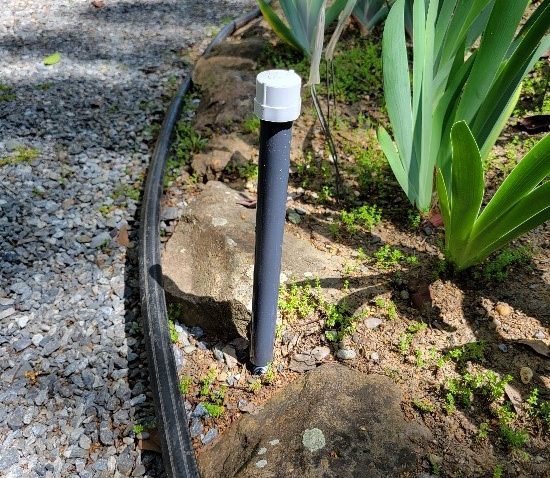
Threaded PVC and cap over rebar
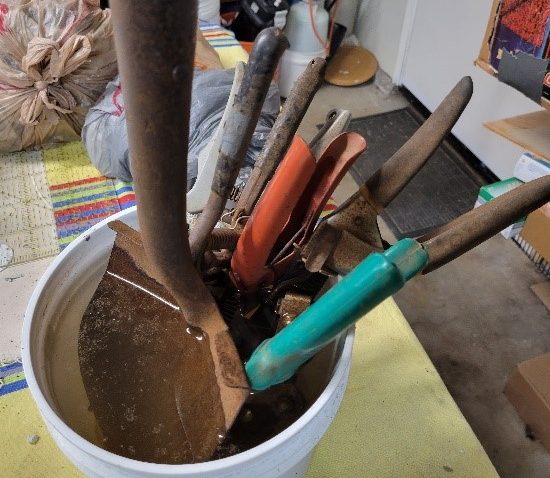
by Stan Logan | May 9, 2022 | Garden tools
This is the second article about removing rust from garden tools. As you can see be the photo below, I have placed a little shovel (garage sale) and 5 shears (close gardening friend) in a bucket. All of these tools were severely rusted. The liquid is a 50-50 solution of vinegar and water. When I removed the tools after a couple of days, they were covered by a thin black coat of another form of iron oxide. My power washer easily removed that coat, but you may wish to leave it be. You can get an idea of the severity of the rust problem in the second photo where the acid did not cover the entire shovel blade. I am currently soaking that shovel in a plastic tub to get rid of the rest of the rust. The 5 shears came out great and I coated them with WD-40 and let them dry so oxygen couldn’t get to the expose iron. The shovel will get a spray paint application.
Now, I have sharpened hundreds of tools, and most of them have some degree of rust on them. For the most part a little rust doesn’t affect the function of a tool. What is more detrimental is the accumulation of dried plant juices and an application of oven cleaner and a brush makes quick work of that. So, you may not give a hoot about rust on your tools. But if you happen to leave a tool outside for while where moisture can get to it, why not turn it into a fun chemistry experiment. For 3 dollars you can buy a gallon of vinegar at Target, and you are ready to go. If you want to try other experiments, google “removing rust from tools” and you will find various other techniques.
Stan, The Experimenting Man
 Rusty garden tools soaking in 50-50 vinegar-water solution |
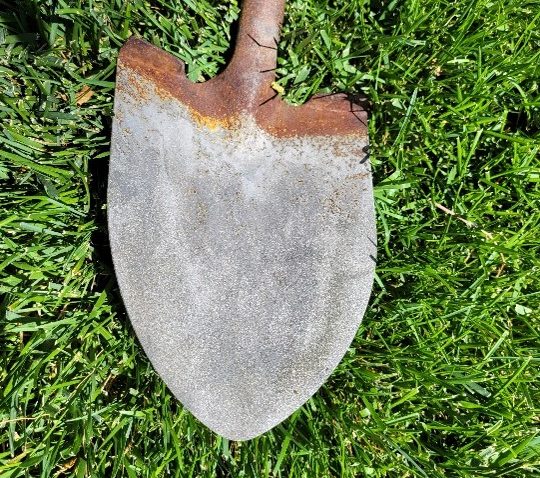 Rust removed from shovel except where not immersed in vinegar solution. |
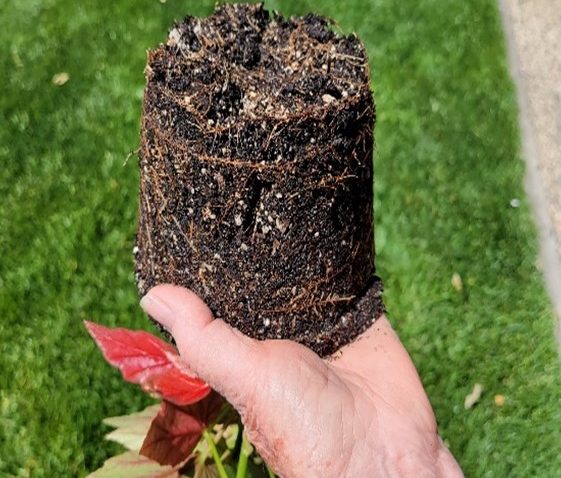
by Stan Logan | May 8, 2022 | Container plants
How do you tell when a potted plant needs repotting? There are several clues. Perhaps your soil moisture tester is no longer able to penetrate the soil. Maybe your plant has to be watered every day. You may find that the water you add to the pot takes forever to soak in.
The sure way to find out is to pop the plant out of its pot. When the pot is small this chore is easy—simply turn it upside down and rap the edge of the pot on a hard surface like your potting bench. Don’t forget to have your hand beneath the plant to catch it when it falls out! Now check the roots. If they are crowding around the edges, it’s time to repot. Now if you have a larger pot, simply get a strangle hold on the basal neck of the plant and tap the top of the pot. We find a rubber mallet works well with this, but a short piece of wood like a 2 x 4 would work.
If you have a plant in a pot that has a constricted top like in the photo below, you have a problem. When you plant in such a pot, repotting will be a real chore. Your two main options are to cut down through the roots all around the periphery with a narrow blade, or you could simply break the pot. A third option is simply to let the plant die a slow, agonizing death. Of course, you could shorten the demise with a quick severing with a pruner. Then you are merely left with the struggle to remove the impacted remains.
Now once you perfect plant popping technique, you may consider using it while checking out the condition of a plant at a nursery before purchase. It would not be wise to invest a great deal in a plant that has been kept in the same pot too long and is now root bound.
LaVille is a professional propagating plant popper and uses this technique constantly to tell when a plant needs repotting. With a little practice you could be a proper popper too.
Stan, The Popper Man
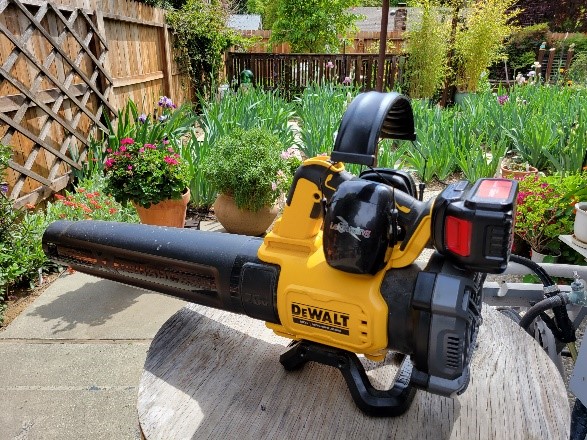
by Stan Logan | May 7, 2022 | Garden tools

DeWalt Cordless Leaf Blower
I put off buying a cordless leaf blower for years. Then one day, feeling self-deserving, I took the plunge and ordered the DeWalt leaf blower you see below. It really sounded good. It was Amazon’s choice. It had a “high efficiency brushless motor”. It was lightweight. It had a variable speed trigger. Finally, it had “low noise during operation (66 decibels)—ideal for noise sensitive regions and properties”. Now, I found everything above to be true . . except for the last claim. I think I just bought a lemon. I read through the reviews for this machine, and not one of them mentioned severe noise levels. LaVille looked up decibel levels and found that 60 decibels is the noise level for normal conversation between two people 1 meter apart. 85 decibels is the road noise you experience inside a car.
So, what do I do? I wear the hearing protection you see perched on the blower. LaVille will not remain outdoors when the blower is running, so I wait until she is inside the house. I try not to use the machine on the weekends and instead blow in the middle of the day during the week.
Yet, I still would recommend this blower for you—my machine must simply be a lemon. It is so easy to grab this blower and immediately clean up a small area. At lease once a week I will touch up the front yard to keep it looking respectable. The machine is light and the speed trigger works really well. You will want a second battery and the DeWalt is rather expensive. Being cheap, I ordered 2 off brand batteries at ½ the price of the DeWalt, and I got what I paid for—not nearly the quality of the original DeWalt battery.
So, if you have a corded leaf blower, you will really be happy with a battery powered blower. No more dragging that cord around doing all kinds of damage. No cord that wheels just love to trap. No twisted cord to wind up and put away. You can go anywhere! Take it with you on vacation. Give the inside of your car a quick detailing by opening the doors and blowing all the trash out. I wouldn’t suggest you try the same with your house though.
If you do order this DeWalt blower, immediately send it back if you find it is a screamer—I wish I had.
Stan, The Blower Man






